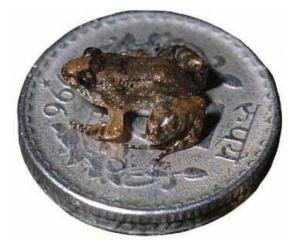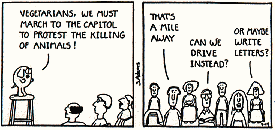The October 15th issue of India Today had an article about Dr. Ritesh Arya, a hydrogeologist, who has turned to drilling for groundwater at very high altitudes in the Himalayas. India Today reporter Ramesh Vinayak interviewed him. Dr. Arya has caused quite a sensation by drilling successfully for groundwater at fifteen thousand feet. The Army and the locals are pleased with him. Villages and army posts which had to bring water by tankers, now have flowing water through bore wells. Hurray for Dr. Arya and his geological skills. Mr. Vinayak's reporting on geology is another matter. Here is what he writes about Dr. Arya's research thesis. "At the heart of his ground-breaking thesis is the finding that groundwater resources in the Himalayan region depend on the type of rocks and structural parameters like folds, fissures and fault-line in the rock strata. I am sure Dr. Arya very skillfully interpreted the geology, but I don't see any ground-breaking revelations here. The parameters that control groundwater occurrence and movement are pretty much the same everywhere, no matter what the altitude, i.e. geological properties of rocks and structural features such as fractures, joints, faults. Then Mr Vinayak writes something bizarre," The mountains have groundwater just like the plains but the water movement at high-altitude is controlled by principles of gravity and iso-stacy (wherein the water level is itself up)". Wow! That must have been the physics class I missed in school. I had no idea water responds to gravity differently in the mountains than in the plains. And what is this iso-stacy? The term is isostacy and it is a concept used to explain why topography exists on a continental scale. The lithosphere, which is the rigid outer shell comprising the earth's tectonic plates rides on a plastic asthenosphere. Plastic in the sense that the material deforms by plastic flow. Imagine a block of wood floating in water. The height of the wooden block above water-level is determined by its density and thickness. The lithosphere similarly rides upon the asthenosphere at a height depending upon its density and thickness. As you must have guessed by now, it has nothing whatsoever to do with groundwater. Here's a suggestion for reporters who are blank about science. Why not ask the scientist being interviewed to write a couple of paragraphs?
Okay, enough harassing the media. On to more geology. Groundwater high in the mountains reminded me of my trekking days in college. Where I live in Pune, the popular places to trek were the Sahyadri mountains, and particularly the various 16th century forts strategically placed along the western ghat escarpments. Many of these forts have fresh water wells. People are often surprised to learn that there is groundwater so high up. The popular thinking is that water will just flow down the slope or through cracks and find the lowest level such as adjoining valleys or plains to accumulate. But there can be plenty of groundwater in these western ghats. These are not orogenic mountains like the Himalayas, but were formed during and after the Deccan Trap volcanic eruptions by a combination of the processes of magmatic underplating and denudational uplift. Magmatic underplating refers to the process whereby much of the melt produced in the mantle during such large magmatic events such as the Deccan Traps does not reach the surface but sticks to the underside of the lithosphere. All this hot stuff makes the lithosphere buoyant causing uplift. Most of the uplift is however thought to be denudational uplift (evidence summarized in Sheth 2007) which refers to the process whereby the lithosphere which has been depressed by the weight of the thick volcanic pile rebounds upon removal of the material by erosion causing uplift. This may take place millions of years after the volcanic event. This is analogous to an iceberg floating in water. If you shave off some ice from the top, the iceberg will rise by a proportional amount. Iso-stacy or rather isostacy is in action in the Deccan Traps as well. The Sahyadris are formed of two main types of basalts which occur as alternating layers; amygdaloidal basalt which solidified from more viscous lava and generally forms gentler erosional slopes and compact basalt which solidified from more fluid lava and forms steeper slopes as seen in image below.
 Groundwater systems can occur in both types of basalt. My friend Dr. Himanshu Kulkarni has studied these basalt groundwater systems extensively. After two decades of research, some general principles are emerging. Basalts are crystalline rocks with an interlocking fabric of crystals. So, water in these rocks is stored and flows along cracks, joints and fractures. Both, horizontal sheet joints and vertical joints serve as conduits for water flow. Amgdaloidal basalt is generally the more capacious in water storage and high yielding aquifers are those where a layer of amygdaloidal basalt is underlain by the more impermeable compact basalt (Kulkarni et. al. 2000). The figure below illustrates these concepts of basalt hydrogeology.
Groundwater systems can occur in both types of basalt. My friend Dr. Himanshu Kulkarni has studied these basalt groundwater systems extensively. After two decades of research, some general principles are emerging. Basalts are crystalline rocks with an interlocking fabric of crystals. So, water in these rocks is stored and flows along cracks, joints and fractures. Both, horizontal sheet joints and vertical joints serve as conduits for water flow. Amgdaloidal basalt is generally the more capacious in water storage and high yielding aquifers are those where a layer of amygdaloidal basalt is underlain by the more impermeable compact basalt (Kulkarni et. al. 2000). The figure below illustrates these concepts of basalt hydrogeology. Source: Advanced Center for Water Resources Development and Management
Source: Advanced Center for Water Resources Development and ManagementSuch conditions for the formation of a groundwater system are met at many of the high-altitude forts. At Sinhagad, one of the most popular forts near Pune, there are several fresh water wells and storage tanks that have exploited such structural zones of groundwater flow.
 In image the brown arrows point to horizontal sheet joints developed at the junction of two lava flows. Such joints among other joint systems form a zone of groundwater flow (blue arrows). The well indicated by the pink arrow captures this flow. The circular green spots are additional water storage tanks.
In image the brown arrows point to horizontal sheet joints developed at the junction of two lava flows. Such joints among other joint systems form a zone of groundwater flow (blue arrows). The well indicated by the pink arrow captures this flow. The circular green spots are additional water storage tanks.Groundwater exploration "consultants" have got a bad reputation, sometimes richly deserved, in my part of the country in the state of Maharashtra. People now have smartened up but in the bad old days there were scamsters walking around with a magnetic compass claiming to locate water, and then those who dabbled in dowsing. It was great to read that Dr. Arya relies on sound geological principles for his explorations. In any case, dowsing in the mountains can be dangerous.
 What I would like to know is if the principles of dowsing are any different in the mountains than in the plains.
What I would like to know is if the principles of dowsing are any different in the mountains than in the plains.References:
H. Kulkarni, S. B. Deolankar, A. Lalwani, B. Joseph, S. Pawar, 2000; Hydrogeological framework of the Deccan basalt groundwater systems, west-central India; Hydrogeology Journal; Volume 8, Number 4, p. 368-378.
Hetu C. Sheth 2007; Plume-related regional pre-volcanic uplift in the Deccan Traps: Absence of evidence, evidence of absence; Hetu C. Sheth; In www.MantlePlumes.org







